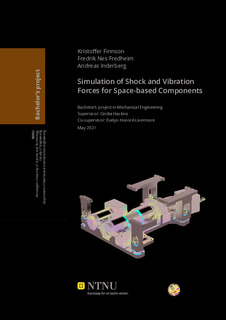| dc.contributor.advisor | Haskins, Cecilia | |
| dc.contributor.advisor | Honoré-Livermore, Evelyn | |
| dc.contributor.author | Finnson, Kristoffer | |
| dc.contributor.author | Fredheim, Fredrik Nes | |
| dc.contributor.author | Inderberg, Andreas | |
| dc.date.accessioned | 2021-09-24T18:24:14Z | |
| dc.date.available | 2021-09-24T18:24:14Z | |
| dc.date.issued | 2021 | |
| dc.identifier | no.ntnu:inspera:81018274:82250651 | |
| dc.identifier.uri | https://hdl.handle.net/11250/2781767 | |
| dc.description.abstract | Denne oppgaven handler om sjokk- og vibrasjons-simuleringer av en satellitt, som en del av HYPSO-prosjektet ved NTNU. Hensikten med arbeidet som blir presentert i denne oppgaven er todelt: For det første er det en måte å utforske hvordan sjokk og vibrasjoner påvirker satellitten, og for det andre utvikles en metode for å sette opp simuleringer, som kan bli brukt og videreutviklet av andre satellittprosjekter i fremtiden.
Oppgaven beskriver arbeidsprosessen som førte til oppsettet av simuleringer. Denne prosessen startet med idealisering (forenkling) av komponenter som skal simuleres, og fjerning av komponenter som blir ansett som mindre kritiske eller for kompliserte til at en simulering vil være nøyaktig. Deretter ble det satt opp en analyse ved hjelp av elementmetoden (FEM) ved å definere forbindelser mellom delene og bestemme begrensninger og laster for simuleringen. Det ble gjennomført simuleringer som gjenskaper forholdene under fysiske tester, og sammenligninger mellom disse simuleringsresultatene og de tilsvarende testresultatene ble brukt til å evaluere nøyaktigheten til simuleringsmodellen.
Etter å ha kjørt flere simuleringer, viste resultatene at den simulerte modellen har høyere resonansfrekvenser enn den fysiske modellen, i tillegg til at akselerasjonene ved sjokk og vibrasjoner var høyere. Hovedårsakene til disse forskjellene er sannsynligvis at den simulerte modellen er stivere enn den faktiske satellitten, og at de fleste simuleringene ble gjennomført uten dempere. Mot slutten av prosjektet ble det kjørt noen simuleringer med dempere, og de innledende resultatene virket lovende, noe som viser at dempere er nødvendige for at simuleringer av satellitten skal bli realistiske. | |
| dc.description.abstract | The focus of this thesis is on shock and vibration simulations of a satellite as a part of the HYPSO project at NTNU. The purpose behind the work presented in this thesis is twofold: Firstly it is a way of exploring how shock and vibrations affect the satellite, and secondly it develops a method for setting up simulations that can be used and further developed by other satellite projects in the future.
The thesis describes the work process that led to the setup of simulations. This process started with idealization (simplification) of components that were to be simulated, and the removal of components that were considered less critical or too complicated for a simulation to be accurate. Then, finite element method (FEM) models were prepared by defining connections between the parts and determining simulation constraints and load scenarios. Simulations that replicate the conditions from physical tests were conducted, and comparisons between these simulation results and the corresponding test results were used to evaluate the accuracy of the simulation models.
After running several simulations, the results showed that the simulated models had higher resonance frequencies than the physical model, and also experienced higher peak response accelerations to shock and vibrations. We believe the main reasons for these differences are that the simulated models are stiffer than the real satellite, and that most simulations were performed without dampers. Towards the end of the project, a simulation model with dampers included was created, and their preliminary results showed promise, proving that dampers are necessary for simulations of the satellite to be realistic. | |
| dc.language | eng | |
| dc.publisher | NTNU | |
| dc.title | Simulation of Shock and Vibration Forces for Space-based Components | |
| dc.type | Bachelor thesis | |
